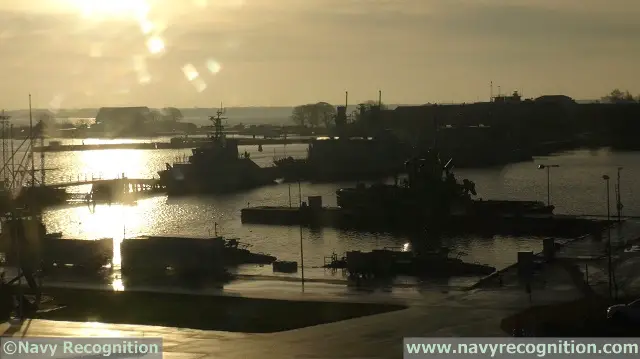Video: Swedish Navy Karlskrona Naval Base, Koster-class MCMV & Visby-class Corvette
|
|
|||
 Karlskrona Naval base in Southern Sweden at sunrise in late November Karlskrona Naval base in Southern Sweden at sunrise in late November |
|||
|
|
|||
|
It is also home of several ancient dry docks made of stones. Because of these attributes, the naval base is now a UNESCO World Heritage Site since 1998. Today the Swedish Navy 1st Submarine Flotilla and 3rd Naval Warfare Flotilla are based in Karlskrona, making it the largest naval base in Sweden.
It is also home of Swedish Shipyard Kockums which was acquired by Saab in July 2014. Saab is currently modernizing two Gotland-class submarines as well as building two A26 next generation submarines for the Swedish Navy in the shipyard. |
|||
|
|
|||
|
Our video on Karlskrona naval base
|
|||
|
|
|||
|
During our visit we had the chance to get aboard the Koster-class mine countermeasures vessel Vinga. Most MCM vessels are dedicated to minewarfare. However The koster-class is a multi role vessel capable of minehunting, minesweeping minelaying as well as anti air wafare and anti surface warfare for self defence and anti submarine warfare in brownwater.
The vessel belongs to the 33rd Minelayer Squadron. It has been modernized with new CIC, ROVs and Fire Control in the late 2000s. Koster class MCM vessels displace roughly 400 tons, with a length of 47.5 meters. They have a maximum speed of 14 knots and autonomy of 2000 nautical miles. The crew complement is 29 sailors. They have a Glass Fiber Reinforced hull. We were shown the minewarfare equipment aboard the vessel such as a Mine disposal charge, a double eagle ROV by Saab used mine reconnaissance and disposal. The Swedish navy also uses the Seafox ROV for blowing mines up. The crew even tested it against a bottomed submarine giving it a limited ASW capability in brown waters. Also present at the stern of the ship are Depth Charges which can be used against submarines. Overall, the Swedish navy is using its Koster class MCM vessels for minehunting in sea lanes in the baltics, in anchorage areas, in harbor and for leadthrough operations. They also serve as mother ship for divers for various diving tasks such as mine disposal and examination of wrecks. Finally they are used for ASW (detection classification and attack of submarines) and they can act as patrol boats for sea traffic control. For anti surface and anti air warfare, the vessel is fitted with a manned 40mm Bofors main gun. During our visit, the XO confirmed that Vinga is considered a surface combatant ship in the Swedish Navy. The officer praised the maneuverability and endurance of the ship. The class is set to be replaced in the next 10 years. Saab Kockums is pitching its new generation MCMV 80 design as a possible replacement. |
|||
|
|
|||
 A Visby-class corvette A Visby-class corvette |
|||
|
|
|||
|
After the Vinga, we got aboard the Visby-class Corvette Karlstad, the fifth and last ship of the class.
Despite its design dating back from the 90ies, the Visby class corvette still looks like one of its kind with a very unique, advanced and futuristic shape. Those corvettes displace 650 tons, with a length of 72.8 meters. They have a maximum speed in excess of 35 knots and a range of 2500 nautical miles. The crew complement is 43 sailors. They have a Carbon Fiber Reinforced Plastic hull capable of breaking thin layers of ice. The Karlstad corvette belongs to the 3rd Naval Warfare Flotilla. The Visby class key feature is its angular design which reduces its radar cross section to a minimum. Even the anti ship missiles and radar systems are enclosed in the structure. The only systems which stand out are the 57mm main gun and the Saab CEROS 200 fire control radar. But both of them are still hidden behind shape optimized shields. According to the Karlstad's commanding officer the visby class can conduct a vast range of missions such as Anti-surface warfare, anti-submarine warfare, anti air warfare, anti asymmetric warfare, electronic warfare, minewarfare, ISR, and command and control. For Anti surface warfare, the Visby class can launch up to 8x RBS-15 Mk2 anti-ship missiles. Designed by Saab, those missiles have a range of about 70 Km. Saab has received a contract this year to design a new anti-ship missile to be fitted on the Visby class. The ASW systems are fitted below the helicopter pad such as racks to deploy sea mines and depth charges, up to four torpedo launchers and a towed array sonar system. The vessel is fitted with the Saab 9LV combat management system. The commanding officer of the Karlstad gave us his personal opinion on the pros & cons of the Visby class. Advantages include a design which maximizes stealth and which is multipurpose, its maneuverability, its high speed and the fact it is optimized for littoral operations typical in the Baltics. Some of its disadvantages include its very lean manning, the crew has to be able to multi task. The Visby endurance, high fuel consumption and the fact it is limited to below sea state 5 are also aspects that the Commanding Officer would like to improve, if he could. The Visby class is set to be upgraded in the coming years. In addition to the new anti-ship missile they may receive surface to air missiles, this would be a game changer for the Swedish navy since today, the corvettes have no SAM system. |
|||


























